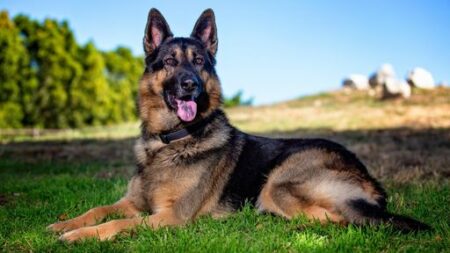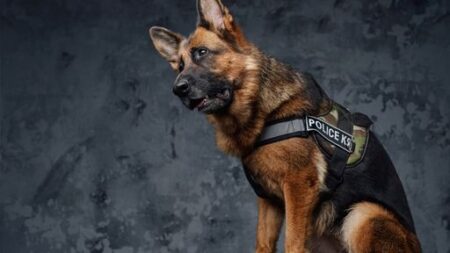Blue heelers are a very intelligent breed of dog. However, they can be difficult to potty train because they have a high prey drive and often run off after small animals if given the opportunity.
Before you start training your blue heeler puppy how to use the bathroom outside, there are some things you should know about how their mind works so that you can design an effective strategy for how to potty train them.
So in this blog post, I’m going to explain how to potty train a blue heeler puppy in just a few easy steps. I’ll also answer some frequently asked questions about this process and give you a few tips to make it go as smoothly as possible.
Are Blue Heeler puppies hard to potty train?
This is a question that many first time dog owners ask. The answer, however, is not as straightforward as one might think.
Blue Heelers are notorious for being hard to potty train, but this does not mean they cannot be successfully house trained.
It simply means that cattle dogs will take more effort and patience on the owner’s part when it comes to potty training.
To successfully house train a blue heeler puppy, you have to know a few things
First, you have to understand how their mind works so that you know what motivates them.
Second, you need to take a very gradual approach to potty training.
Finally, you should never scold your blue heeler puppy if they make a mistake.
It will only confuse them and make the process more difficult. Instead, simply clean it up and start over again with your training regimen when your pup makes a mistake.
When You Should Start The Process Of House Training Your Blue Heeler

Start potty training as soon as you bring your puppy home. The earlier you start, the quicker and easier it will be for both of you.
You can start his training as early as 12 weeks old or even younger.
Blue heelers are easy to housetrain, but they do have a few quirks.
They will let you know when they need to go outside by standing at the door or whining.
The Importance Of Crate Training
Crate training is also an important part of housebreaking your cattle dogs. A crate will provide him with a safe place to sleep and prevent him from eating things he shouldn’t.
It will also make it easier to housetrain him because you can confine him when you are not home.
Crate training is also an important part of housebreaking your blue heeler.
A crate will provide him with a safe place to sleep and prevent him from eating things he shouldn’t. It will also make it easier to housetrain him because you can confine him when you are not home.
It also helps in pee and potty time. When my blue heeler puppy wakes up from his nap, I will put him in the crate and give him a few minutes to pee or pooty.
After that, I will take him out and play with him for a while before putting him back in the crate for his next nap. This helps to establish good potty habits early on in his life.
How to Potty Train a Blue Heeler Puppy The Defining Steps
Get Them A Specific Place
The first step in potty training your blue heeler puppy is getting them used to being in the same place every time they do their business.
This means that you should designate an area outside (or inside if you have a covered area) where your puppy will always do their business and take them there every single time they need to go.
These drills with puppies are called ‘potty breaks’ and are crucial for teaching your young dog that there is a specific place for them to relieve themselves.
Monitor Your Pet’s Activities
Once a comfortable spot is designated, you must never let your blue heeler pup out of your sight when they’re in the house.
In addition to this, make sure that all doors of the house or apartment complex are closed so that they can’t get outside whenever nature calls.
If possible, put some sort of baby gate on any stairs leading up from downstairs to make the experience helpful so they can’t climb them while you aren’t looking.
This way, if anything happens or an accident occurs, it won’t lead anywhere!
Establish A Potty Training Schedule And Stick To It
So the next step in how to potty train a blue heeler puppy is teaching them what an appropriate place to do their business looks like.
This means taking your pup out of the house on a leash every time they seem ready and going through a process called “marking,” where you take note of any behavior indicative of needing to go out (sniffing around or circling).
Then after this point of basic training, make sure that they go to the designated area you picked out earlier once outside for potty break.
If you catch them in the act and take them outside right after, then they’ll quickly learn that this is what good behavior looks like.
Give Them Frequent Potty Breaks
In addition to all of the steps above, one of the most important things you can do when potty training a blue heeler puppy is to give them frequent potty breaks of 5-10 minutes.
Instead of taking them out once every few hours, you should be taking them out at least every hour for the first few days.
If you’re keeping up with their consistent schedule of doing this often, they’ll get used to it faster and will eventually only need to go out a few times a day.
Reward Your Puppy For Going Potty In The Right Place And Be Consistent
The final step in how to potty train a blue heeler puppy is consistency with realistic expectations.
This means taking your pup out at the same times every day for a few weeks and rewarding them with treats whenever they show signs of going to the designated area.
This will teach your pup that it’s good to go there every time, making them want to do their business in this specific spot. And don’t worry if accidents happen sometimes it’s all part of the process of Australian cattle dogs.
These steps are equally effective on aa 8-week-old puppy or a 5-month-old puppy. They play a vital role in blue heeler potty training regardless of how months of age they are.
Is Creat Training Helpful In Potty Training a Cattle Dog?
When potty training, a Blue Heeler Puppy makes use of a crate for positive training and to prevent accidents.
A crate is a great tool when potty training your Blue Heeler Puppy because it will allow you to confine them whenever they aren’t supervised and release them as soon as they need to go outside to train them properly.
Additionally, you should also keep this energetic breed on a leash when taking them outside.
While the crate training method may not be the best option for your pup’s personality type, it will help prevent accidents from happening inside the house and give you more control over their actions while out in public or around other animals.
Potty Training Mistakes And How To Avoid Them
1. Do not let your puppy out of sight if they’re in the house. If an accident happens, during cattle dog training then at least it won’t lead anywhere!
2. Do not scold a puppy after the accident. They won’t understand why they are being punished and will become nervous or even scared of you, which means accidents happen more often.
3. If an accident occurs, clean it up immediately with some water and vinegar to remove all smells that could attract your pup back to the same spot.
4. Be patient and avoid common mistakes during stressful times. It takes plenty of time and advanced training sessions for your puppy to understand what they’re doing and when they need to go potty.
Stay calm even if it becomes frustrating; accidents will happen in their diligent potty training until you reach 30 days periods of time of obedience training.
5. Do not give up or get impatient with them too quickly, especially before the 30 days or a month mark is over because this could lead to a lifelong problem that is hard to fix later on down the line.
One accident at home can cause trust issues between you & your pup, making potty train puppies very difficult.
6. Finally, have a lot of patience and treats ready because your pup will most likely be rewarded with plenty of fun activities and crunchy treats for showing good behavior! And before you know it, they’ll be successfully potty trained cattle dogs.
What To Do If An Accident Happens Inside The House
If your Blue Heeler Puppy has an accident in the house, then they mustn’t be punished for this behavior once they return inside after being let out outside with a leash on.
The best way to do this is by taking them back to accident spots where the accident occurred and making sure that there isn’t any residual scent, amounts of water, or mess left behind so that they can see their mistake wasn’t made in vain!
Then, when you bring them back into the house, take them immediately outside again without punishing them since accidents sometimes happen, even if your pup was doing everything right beforehand!
These mental activities will help them to understand that they need to go outside to relieve themselves and not inside the house where they live. Moreover, with these mental activities and house training solutions like this, your pup will learn to trust you more and know that you’re only trying to help them in the long run!
One of the things a pet owner frequently asks about respect training blue heelers how to potty train is how long the process usually takes.
In my experience with heelers, blue heeler training can take anywhere from a few days to a couple of weeks for your pup to fully get the hang of things, but this will always vary depending on each dog.
Conclusion
In conclusion, pottyIn conclusion, potty training a blue heeler puppy is a process that takes patience and diligence, but with these tips, it can be much easier than you might think!
By following these simple steps, you’ll have your Blue Heeler Puppy using the bathroom outside in no time.
Frequently Asked Questions (FAQs)
How do I stop my blue heeler from peeing inside when I’m not around?
Make sure they are always supervised when they’re inside and put up a baby gate when you can’t watch them to keep them in one room.
When they go potty outside, reward them with a treat or belly rub – this will teach your pup that going outside is much more rewarding than using the bathroom inside.
Are Blue Heeler puppies easy to train?
Yes! Blue Heelers are excellent companion and easy to train because they love learning new things.
Just be patient with them – once your pup learns how you want them to act, it will become second nature.
Start with basic commands like sit and stay, and then move on to more complicated tasks. Soon enough, you’ll be able to take your pup anywhere without a leash!
Can a Blue Heeler be an inside dog?
Yes! Blue Heelers do just fine being inside dogs or apartment dogs.
They’re a medium-sized breed of dog so they won’t take up too much room in your home.
They’re also fairly calm and chill, so they’ll be fine with hanging out inside – just make sure there’s always someone at home to give these family dogs attention so they don’t develop any bad behaviors or annoying behavior problems.
Is a Blue Heeler good for first-time dog owners?
Yes! Blue Heelers are great adult dogs for new dog parents because they’re easy to train.
As long as you’re patient and consistent with your potty training method, your pup will learn the ropes in no time!
Plus, Blue Heelers are friendly and loyal. Once you earn their trust, they’ll be by your side for life!
What is the best age to potty train a puppy?
The best age for potty train a cattle dog is between six and seven months old. Your pup will have the energy and basic training skills they need to learn how you want them to behave, but they’ll also be old enough to understand what you’re trying to teach them.
Start with positive reinforcement training with basic commands like sit and stay, and then move on to more complicated tasks.
However, if required aversive training techniques along with positive reinforcement may be used to help with more difficult behaviors.
How much exercise does a Blue Heeler puppy need?
An Australian cattle puppy needs at least one hour of exercise per day. This could include a long walk, playing games of fetch in the backyard, or going to the dog park.
Make sure your dense undercoat pup gets plenty of physical exercise on a regular schedule. Because physical exercise will not only will it help them stay healthy, but they’ll also be less likely to get into trouble when they’re bored.
Do Blue Heelers turn on their owners?
Blue Heelers are very protective and have undying loyalty. Some can be suspicious of strangers, but they’re not likely to turn on their owners.
They make great family pets and guard dogs and will always be happy to have a home with their family.
As long as you provide your pup with plenty of daily exercise, bit of attention, effective training, and their favorite treats they’ll be well-behaved no matter where you are!
Are Blue Heelers aggressive?
Blue Heelers can be a bit aggressive when it comes to protecting their family and territory.
They’re not likely to attack strangers, but they will bark and growl to let them know they’re not welcome.
However, with an effective training method, enough exercise, attention, positive reinforcement, and training classes, your Blue Heeler can be a well-behaved and friendly dog for their prospective owners.
Are Blue Heelers good with kids?
Yes! Australian cattle dogs and breed of puppies are very friendly and love to play with children. Just make sure your kids know how to interact with dogs properly and supervise any interactions between them and your pup.
They’ll get along great, and your Blue Heeler will be a loyal companion to you and the whole family.
Do puppies need puppy pads?
Yes. If you’re not yet in the routine of taking your Blue Heeler outside to use the bathroom, potty pads or Puppy pads are a great idea.
Just remember to keep them on a schedule so your pup gets used to the idea of only going potty outside. Regular breaks of 15-30 minutes will also improve their bowel control.
What is dog potty training spray?
Dog potty training spray is the best way for your dog to communicate with you. It’s like your dog’s natural pee and poop odor but in a spray.
It’s a temporary solution that you apply to your dog’s urine and poop while he is going potty so you can quickly and easily find the source of the smell and the exact spot.
Why do Blue Heelers pee so much?
Regardless of the reason, there’s no denying that blue heelers have a reputation for being, well, puddle-makers.
One theory is that blue heelers tend to mark their territory more often than other breeds of dogs. This is likely due to their herding instinct; by urinating frequently, they are able to establish and maintain their dominance over a given area.
Another theory is that blue heelers simply drink more water than other dogs, leading to a greater need to relieve themselves. This is especially true in hot weather when blue heelers are more prone to dehydration.
Welcome to my blog, where I share my love for all things canine! As an older lady who has spent a lifetime surrounded by dogs, I feel it’s important to share my experiences and the joy that these furry companions bring into our lives. From my first dog, a spunky little mutt, to the loyal and loving dogs who have been by my side throughout the years, each one has left an paw print on my heart. Through my blog, I hope to inspire others to appreciate the love, loyalty, and companionship that dogs bring. So come along on this journey with me as we celebrate the wonderful world of dogs!





